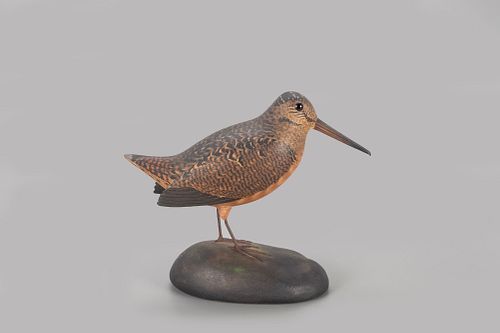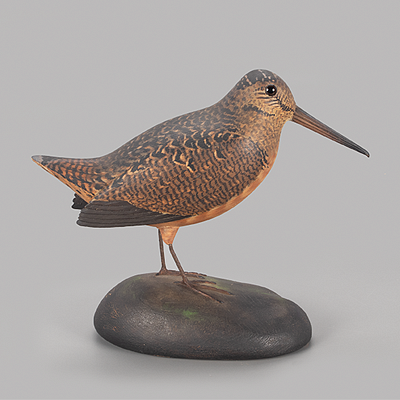The du Pont Crowell Woodcock, A. Elmer Crowell (1862-1952)
Lot 23
About Seller
Copley Fine Art Auctions
20 Winter Street
Pembroke, MA 02359
United States
Founded in 2005, Copley Fine Art Auctions is a boutique auction house specializing in antique decoys and American, sporting, and wildlife paintings. Over the course of the last two decades, the firm has set auction records for not only individual decoy makers, but also entire carving regions. Copley...Read more
Estimate:
$70,000 - $100,000
Absentee vs Live bid
Two ways to bid:
- Leave a max absentee bid and the platform will bid on your behalf up to your maximum bid during the live auction.
- Bid live during the auction and your bids will be submitted real-time to the auctioneer.
Bid Increments
| Price | Bid Increment |
|---|---|
| $0 | $50 |
| $1,000 | $100 |
| $2,500 | $250 |
| $5,000 | $500 |
| $10,000 | $1,000 |
| $25,000 | $2,500 |
| $50,000 | $5,000 |
About Auction
By Copley Fine Art Auctions
Jul 14, 2022
Set Reminder
2022-07-14 10:00:00
2022-07-14 10:00:00
America/New_York
Bidsquare
Bidsquare : The Sporting Sale 2022, Day 1
https://www.bidsquare.com/auctions/copley/the-sporting-sale-2022-day-1-9460
Lots 1-332 Copley Fine Art Auctions cinnie@copleyart.com
Lots 1-332 Copley Fine Art Auctions cinnie@copleyart.com
- Lot Description
The du Pont Crowell Woodcock
A. Elmer Crowell (1862-1952)
East Harwich, MA, c. 1912
10 1/4 in. long
“During Elmer Crowell’s youth, the landscape of the Cape was experiencing a regrowth of its forests. Before the arrival of Europeans, Native Americans lived in primarily pine and oak forests, with hickory, beech, cypress, red maple, and birch trees interspersed. Early colonial settlers vastly diminished these forests by cutting down trees in order to sustain themselves in their new land. Wood was used to build and heat homes, and the cleared land was utilized to grow food and graze livestock.
In the late 1800s, as the human population on the Cape declined, timber was no longer in such high demand and trees began to repopulate the landscape. This pattern of land use was beneficial to bobwhite quail, woodcock, and ruffed grouse that thrive in the mixed vegetation of an early-stage regrowth forest. Today these species are not commonly associated with Cape Cod; however, they were fairly abundant in Crowell’s time.” — Chelsie Olney and Stephen B. O’Brien Jr., “Elmer Crowell: Father of American Bird Carving”
This masterwork represents not only one of the maker's earliest and best carvings of the species, but also one of his pinnacle paint applications on any game bird. Of particular note are the dropped wings with carved primary feathers. A closely related example with this treatment from the James and Diane Cook Collection is prominently featured in “Elmer Crowell: Father of American Bird Carving.” Another early example without the dropped wings emanated from the collection of top Crowell patron Dr. John H. Cunningham.
This early decorative woodcock bears the maker's crisp oval brand on the underside of its carved wooden base. The undulating base reveals three painted probing holes to emulate where the timberdoodle has just fed. The grand body is outfitted with a bill which displays precise incised carving along all sides of and between the mandibles. It is finished with a subtle, but deliberate curvature to the very tip of the bill. The species' complex plumage is masterfully applied with tight feathering with high contrast along the top and soft blending in the rich underside.
The form, intricate and accurate carving details, exquisite paint, superb condition, and distinguished provenance of this newly discovered mantle carving place it among the finest of all of upland bird carvings.
This lot hails from the same du Pont family collection as the Crowell mallard and blue jay in this sale.
Excellent original paint with light wear. Typical restoration to thighs and toes, and a spot of minor touch-up just above bill.
Provenance: Eugène E. du Pont Collection, acquired directly from the artist
Private Collection, by descent from the above
Literature: Stephen B. O'Brien Jr. and Chelsie W. Olney, "Elmer Crowell: Father of American Bird Carving," Hingham, MA, 2019, p. 46, very closely related woodcock illustrated.Please email condition report requests to colin@copleyart.com. Any condition statement given is a courtesy to customers, Copley will not be held responsible for any errors or omissions. The absence of a condition statement does not imply that the lot is in perfect condition.Condition
- Shipping Info
-
Shipping info
Copley does not offer in-house packing or shipping. For clients who require shipping, please complete the Shipping Release Form and return it with your payment. The form includes a list of shippers we frequently work with.
-
- Buyer's Premium



 EUR
EUR CAD
CAD AUD
AUD GBP
GBP MXN
MXN HKD
HKD CNY
CNY MYR
MYR SEK
SEK SGD
SGD CHF
CHF THB
THB




















